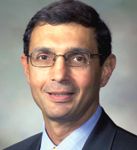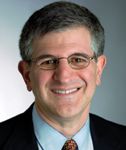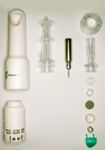The Avian Few: Is it Too Late for Pharma to Re-enter the Vaccine Fray?
Like the course of a pandemic itself, the great avian influenza scare came in waves. In 1997, the first case of the now infamous H5N1 strain of bird flu emerged in Hong Kong, infecting 18 people and killing six. In late 2003 it struck again-more than 120 people fell ill and at least 60 died over the next two years. Then this fall, David Nabarro, MD, the UN coordinator for avian and human influenza, shocked everyone when he said a bird flu pandemic could claim up to 150 million lives-a figure the World Health Organization (WHO) quickly retracted.
Like the course of a pandemic itself, the great avian influenza scare came in waves. In 1997, the first case of the now infamous H5N1 strain of bird flu emerged in Hong Kong, infecting 18 people and killing six. In late 2003 it struck again—more than 120 people fell ill and at least 60 died over the next two years. Then this fall, David Nabarro, MD, the UN coordinator for avian and human influenza, shocked everyone when he said a bird flu pandemic could claim up to 150 million lives—a figure the World Health Organization (WHO) quickly retracted.
Meanwhile, Americans witnessed nature's destructive capacity at home. Hurricane Katrina struck the Gulf Coast on August 29, and as the waters ebbed over the next few weeks, the nation mourned hundreds of victims. The storm, and the broken levees, left thousands homeless and sparked outrage at the government's failure to prepare for the disaster. The message was clear: The catastrophe may have been inevitable, but better government preparation should have softened the blow.
As media frenzy over Katrina subsided, influenza assumed the front page. A pandemic outbreak was no longer a question of if, said Jai P. Narain, MD, director of WHO's Department of Communicable Diseases. It was a question of when.
The alarm had sounded.
Lines of Defense
Flu pandemics occur in cycles, with the last three occurring in 1918, 1957, and 1968. The next outbreak is due any year now, but no one knows when.

Dominick Iacuzio, Roche
More important, no one knows what viral structure the avian flu will take. The virus must mutate before it can jump from person to person, and since it travels in fast-moving swarms, pinpointing its future molecular structure can be tricky. H5N1 is the prime pandemic suspect, but even so, "you're guessing it's a specific subtype of H5N1, which you never know," says Norbert Bischofberger, executive vice president of Gilead Sciences. "Your vaccine may not produce antibodies that effectively neutralize the [mutant] virus."
Vaccines are also too slow. Even after a subtype of the pandemic strain is isolated, manufacturing a vaccine will take six to eight months. The 1918 Spanish influenza virus killed as many as 25 million people worldwide in 25 weeks, so six to eight months may be too long to wait.
Antivirals
The likely first line of defense, many health officials agree, is antivirals, a belief that has contributed directly to Swiss drug maker Roche Holding AG's bottom line. As concerns over an outbreak mounted this fall, governments around the world competed to stockpile Tamiflu, the trade name for oseltamivir, a Roche-licensed drug widely regarded as the best treatment against influenza.

Norbert Bischofberger, Gilead
Oseltamivir was discovered at Gilead in the mid-90s, shortly after scientists in Australia-based Biota learned that the flu virus's neuraminidase protein could be inhibited. Gilead researchers closed in on a compound around Christmas in 1994. "People were so excited," Bischofberger recalls. "Once you're so close, you really can't sit at home and eat Christmas cookies." Soon after New Year's, Bischofberger and his team had a compound.
Gilead licensed the product to Roche in 1996. The two companies settled a long-running dispute about terms of the deal on November 16, when Roche agreed to pay Gilead $62.5 million in retroactive royalties, along with $18.2 million it had already paid under protest. Gilead's royalty remains 14 to 22 percent, depending on sales volume.
In the meantime, Roche is cashing in on Tamiflu. The neuraminidase inhibitor has proven effective against all strains of influenza, provided it's taken within 48 hours of infection. In vitro laboratory tests have shown Tamiflu to work against H5N1. And although researchers caution that lab results don't always translate to the real world, they apparently do translate into real revenue. Tamiflu's global sales through Q3 2005 were up 362 percent over the same period last year, while the company's total earnings are up 17 percent from a year ago.
Anticipating a surge in global demand, Roche doubled its manufacturing capacity of Tamiflu in each of the last two years. By the middle of 2006, Roche expects its production capacity to have increased eight- to ten-fold since 2003, according to Roche medical director Dominick Iacuzio. But supply still lags behind demand. In October the company temporarily suspended delivery of its drug in the US to prevent "Tamiflu runs" and bulk purchases from people who try to hoard the product for personal use. A Roche spokesperson said the company has enough drugs to manage any outbreak in the United States.

Paul Offit, vaccine expert
Concern over a possible shortage prompted governments and competitors to make runs at Roche's patent as well. So far, Roche has rebuffed outside companies' requests to produce Tamiflu, citing unique steps in manufacturing—a 10-part process that includes an explosive step involving hydrogen gas and a complicated formulation step involving ethyl alcohol. But the warning didn't deter researchers in India and Taiwan, who separately announced in October that they successfully synthesized working versions of Tamiflu. About the same time, Roche succumbed to mounting pressure and said it would consider granting sublicenses to four companies—Teva Pharmaceutical Industries, Barr Pharmaceuticals, Mylan Laboratories, and Ranbaxy Laboratories—for pandemic planning purposes.
Scientists have explored ways to stretch the Tamiflu supply. According to a 2002 Roche study, combining half-doses of Tamiflu with a generic gout medication may be as effective as a full dose. However, some experts caution that administering partial doses will only increase the number of Tamiflu-resistant flu strains.
Another issue is whether Tamiflu could—or should—be given prophylactically for flu prevention. Tamiflu is FDA-approved for prophylactic use, but some consider that counterproductive. "I think that's the worst thing anyone can do," says Ashir Kumar, MD, a professor of infectious diseases at Michigan State University. "Because if you give it prophylactically, eventually the virus is going to become resistant."
A second type of antiviral on the market is zanamivir, a GlaxoSmith Kline (GSK) product marketed as Relenza. The drug was a dud when it was first launched during the 2000-01 flu season, primarily because it was packaged as an inhaled powder. But faced with a virus as deadly as H5N1, consumers and clinicians are expected to ignore the awkward delivery system.

PowderMed's DNA vaccine delivery device-these so-called "gene guns"-allow users to easily shoot the vaccine into their skin cells. Pending necessary funding for these devices, DNA vaccines could be on the market within the next "one to two years," according to a company spokesperson.
President George W. Bush announced on October 31 that the government would spend approximately $1 billion to stockpile Tamiflu and Relenza, the only two available drugs for flu treatment. The dearth of options worries Jeremy Carver, CEO and founder of the International Consortium on Anti-Virals (ICAV). "Once there's an outbreak and Tamiflu starts being used extensively, there'll be a selection for a resistant form," Carver says. "Relenza has been shown to be effective against that mutated Tamiflu-resistant form, but then what do you do once you've got Relenza-resistant viruses?"
To counter the virus's mutability, Carver suggests developing a wider array of antivirals. The National Institutes of Health (NIH) seems to agree: Earlier this spring, NIH approached representatives at BioCryst Pharmaceuticals to ask the Alabama company to restart research and development on peramivir, a neuraminidase inhibitor the company began developing in the late-90s but shelved in 2002 due to poor clinical results. Unlike scientists at Gilead, BioCryst was unable to package peramivir in an easily soluble pill, but this time around the company will try to formulate the compound as an injectable. Phase I testing in humans is expected to begin next month.
In addition, because of the sudden surge of investors in antivirals, Carver says scientists from six different academic labs around the world have approached ICAV for help in revitalizing their previously stagnant antiviral research. "I believe it's been shortsighted on the part of governments to think they can rely on just one," Carver says. "The evidence is there that resistance is likely to emerge rapidly to Tamiflu, and therefore second and third-line treatments make sense."
Vaccines
The long-term solution, however, is still vaccines. Building an effective pandemic vaccine may be difficult—and designing a perfect one is likely impossible—but companies are still trying.

Kathleen Coelingh, MedImmune scientist
Sanofi-Pasteur, the vaccine branch of the French conglomerate Sanofi-Aventis, won a $100 million contract from the US Department of Health and Human Services in September 2004 to produce two million doses of an H5N1 vaccine in bulk concentrate form. In March Sanofi delivered 8,000 doses of an experimental H5N1 vaccine to the National Institute of Allergy and Infectious Diseases (NIAID), part of NIH, where researchers tested the vaccine in healthy adults to determine the ideal dosage. The vaccine was then sent to Vanderbilt University in October, where researchers ran efficacy and safety tests on elderly patients and children.
Tom Talbot, MD, a Vanderbilt assistant professor of medicine involved in the research, says the goal of the tests were to see "if a vaccine could be produced easily using our existing infrastructure."
Since the vaccine is being developed using a specific strain of H5N1—extracted from a person who was infected in southeast Asia last year—the vaccine isn't expected to offer complete protection. But Talbot notes, "You want to make sure that the process you're developing is safe." And in case of an outbreak, the vaccine offers hope for at least partial protection.
Meanwhile, other companies are working on less conventional products. MedImmune, the only vaccine manufacturer based in the US, signed a cooperative research and development agreement with NIAID on September 27 to design a pandemic vaccine using a live, attenuated virus. The development builds upon 40 years of research. MedImmune has a seasonal flu vaccine called FluMist, launched in 2003, that uses a live, attenuated virus, but the product hasn't been very popular. "Sometimes it takes a few years before people get accustomed to the idea that there is a new and potentially better way of protecting yourself," says Kathleen Coelingh, MedImmune's senior director of scientific affairs, who expects this year's sales of FluMist to increase.
The process of attenuating a live virus begins by cold-adapting it in cell culture. The virus is grown in progressively lower temperatures until it loses its ability to attack cells at body temperature, rendering it safe to introduce into humans. But the virus retains its shape and ability to replicate, so it becomes a sitting duck for the body's immune system.
The novelty of MedImmune's product lies in a "master strain" called the Master Donor Virus (MDV), which acts as a vehicle for attenuating other strains of influenza. Over a 30-year period, NIAID scientists attached about 20 different strains of influenza to the MDV and showed that they were all harmless when introduced into people.
Scientists have already created a live, attenuated version of the H9N2 bird flu virus, which first appeared in Hong Kong in 1999. Animal results for the H9N2 vaccine have been "encouraging," Coelingh says. With the H5N1 strain, researchers at MedImmune and NIAID are using recombinant-DNA technology to pluck the genetic code for part of the bird flu and graft it to the backbone of the MDV. The company hopes to start clinical tests on H5N1 sometime early next year.
As MedImmune and NIAID scientists test more strains of influenza with the MDV, they can expect to offer more protection for the population. "We're very hopeful because our seasonal FluMist data indicate that this live, attenuated vaccine does indeed protect against drift variants," Coelingh says, referring to new, unexpected mutations.
GSK also has invested in new vaccine technology. In September the company announced the acquisition of a facility in Marietta, Penn., which is trying to replace chicken eggs, the substrate used for manufacturing vaccines since the 1950s, with a cell culture. The new process could cut production time by two months. GSK also bought Seattle-based Corixa over the summer and announced plans in September to purchase Vancouver-based ID Biomedical, which has a vaccine production contract with the Canadian government that runs through 2011. The moves increase the vaccine-production clout of a company whose third-quarter vaccine sales have risen by 20 percent, to nearly $700 million.
Then there is Chiron, now part of the Swiss pharmaceutical giant Novartis, which received a $62.5 million contract from the Department of Health and Human Services (HHS) in October to produce a bird flu vaccine using adjuvants, or chemical agents that are added to vaccines to enhance immune response. Chiron's research on adjuvants in the early- to mid-1990s led to the production of MF59, an adjuvant used in the company's seasonal flu vaccine Fluad (commercially available in Europe and other countries but not in the United States). After the H5N1 strain of avian flu surfaced in Hong Kong in 1997, Chiron produced an adjuvanted H5N3 vaccine that offered cross-protection against H5N1. The company ran a series of tests and published its findings in Lancet in 2001, then again in Vaccine in 2003. In April of this year Chiron published updated results in another paper in The Journal of Infectious Diseases.
When H9N2 emerged in 1999, Chiron was again on the scene to make a vaccine for the new strain. "The key message is we've worked on a number of potential pandemic-like strains," says Rob Budge, a Chiron spokesman. "And the point of that work is you can take learnings from that as to how you would construct an optimal vaccine against a pandemic."
Chiron delivered its H9N2 vaccine to NIAID in March and expects to deliver an H5N1 vaccine either this month or early next year.
Pharma's Comeback
Fifty years ago, there were six flu-vaccine manufacturers in the United States. Today there is one, Maryland-based MedImmune. Companies around the world currently manufacture enough vaccine to protect about 900 million people, or less than 15 percent of the global population. The United States receives about 80 million to 100 million doses of flu vaccine each year, which leaves roughly two-thirds of the country unprotected.
"The infrastructure has crumbled," says Paul Offit, MD, a vaccine expert at the Children's Hospital of Philadelphia. "There were protections [against lawsuits] put in place for pharmaceutical companies in the mid-80s, but it was too little too late. I mean, there was just a big exodus from vaccines."
Offit notes that about 36,000 people die of flu each year, "and we don't give enough flu vaccine to prevent epidemics."
Vaccine makers steadily left the market in the latter half of the 20th century due to dwindling demand and rising litigation costs, but that trend is about to change. On November 1, President Bush announced at NIH in Bethesda, Md., that is he asking Congress to "remove one of the greatest obstacles to domestic vaccine production: the growing burden of litigation."
Bush also outlined a $7.1 billion plan calling for better monitoring of the virus, stockpiling antivirals, manufacturing vaccines, and preparing governments and agencies for an outbreak.
"I'm very encouraged by the enthusiasm and all the hard work," says Coelingh, who worked 10 years at NIAID before joining MedImmune in 1994. "As far as I can tell, the expressed intention on the part of policymakers is that we will be moving toward a universal vaccination recommendation in the United States within the next few years."
The bird flu scare, at least for the moment, is forcing pharma and policymakers to work together. After all, a little fear can go a long way.
Looking Ahead
COMBATING A DISEASE as nimble and adaptive as influenza requires scientists to mine for alternative methods of production and revolutionary new products. Here are some ways in which scientists have ventured beyond the conventional in constructing a bird flu defense:
DNA vaccines: UK-based PowderMed is working on DNA vaccine technology that injects the flu virus's nucleotides—usually the ones that code for the protein hemagluttin—directly into a person's Langhans cells in the skin. The person's cells then read that DNA and transcribe it into viral proteins, which allows the body to develop an immune response. The biggest advantage of a DNA vaccine is its short production cycle—about two weeks, compared with the six to eight month cycle required for conventional vaccines.
PowderMed is expected to start Phase II trials early next year (the company is currently lobbying for funding for its vaccine delivery device, shown above). San Diego-based Vical is also working on a DNA vaccine.
Cell-culture vaccines: Several companies, including Chiron, ID Biomedical, and Crucell, a Dutch biotech company, are developing methods for vaccine production using cell cultures instead of embryonic chicken eggs. Mammalian cell substrates can shave one to two months off the egg production time.
Protein vaccines: Novavax—in partnership with Wave Biotech—is working on a Virus-Like Particle (VLP) vaccine. The VLP is comprised of three co-expressed virus proteins—hemagluttin, neuraminidase, and matrix M1—that are injected into the body. The VLP lacks genetic material so it cannot replicate, but animal studies have shown that it triggers an immune response.
Novavax has worked on this product since 2000, and it hopes to get clinical data next year. VLP vaccines have a six-week production cycle, according to Rahul Singhvi, the company's president and CEO.
Viral-vectored vaccine: Researchers at Purdue University have been working on an adenoviral-vector vaccine for H5N1 for the past three years. The production process involves attaching part of the bird flu gene, extracted through standard molecular techniques, to a relatively benign, widely circulating virus called the adenovirus. The vaccine is then injected into the host, where it replicates influenza proteins without harming the host. Lead researcher Suresh Mittal says his team has been tweaking the delivery system (the "adenoviral vector") for the past 10 years. Preclinical results with H5N1 are due later this month.
Nanoviricides: Also called "chemical viruses," these are chemically synthesized agents that destroy specific targets while remaining invisible in their hydrophilic shells to the host's immune system. They are the "cloak and dagger" operatives of medicine, slipping into viruses for the kill before sacrificing themselves in a tidy "post-op cleanup" that leaves no residue or side effects.
That's the vision of Anil Diwan, president of Nanoviricides, a seven-month-old company based in West Haven, Conn. Diwan, who has been developing nanoviricide technology for the past 13 years, acknowledges that his peers in the scientific community ridicule him for believing he can synthesize a drug akin to a "guided missile." But even so, he remains confident that nanoviricides will be commercially available within the next five years (Diwan says animal studies last month showed nanoviricides were safe to use). "There is a real need to find a different approach," Diwan says. "To find a different way of attacking the virus itself."

FDA Outlines Updated Requirement for Placebo-Controlled Trials in Vaccine Research
May 21st 2025In an article recently published by The New England Journal of Medicine, FDA higher-ups Vinay Prasad, MD, MPH; and Martin A. Makary, MD, MPH, wrote that any new COVID-19 vaccine must now be evaluated in placebo-controlled studies.
Addressing Disparities in Psoriasis Trials: Takeda's Strategies for Inclusivity in Clinical Research
April 14th 2025LaShell Robinson, Head of Global Feasibility and Trial Equity at Takeda, speaks about the company's strategies to engage patients in underrepresented populations in its phase III psoriasis trials.
Beyond the Prescription: Pharma's Role in Digital Health Conversations
April 1st 2025Join us for an insightful conversation with Jennifer Harakal, Head of Regulatory Affairs at Canopy Life Sciences, as we unpack the evolving intersection of social media and healthcare decisions. Discover how pharmaceutical companies can navigate regulatory challenges while meaningfully engaging with consumers in digital spaces. Jennifer shares expert strategies for responsible marketing, working with influencers, and creating educational content that bridges the gap between patients and healthcare providers. A must-listen for pharma marketers looking to build trust and compliance in today's social media landscape.